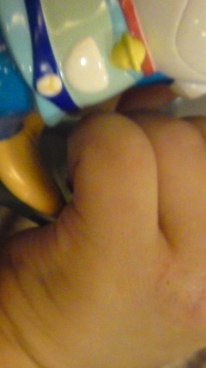
“OH NO, could it be what I ate?” This was what went through my mind when I first read that pregnancy diet could increase the chance of my baby getting eczema (and my baby girl Marcie has eczema since two weeks old). I am not writing this post to put more guilt and blame into your life, but rather, if you’re considering a next child, it will be good to avoid some food or increase the intake of others. There is no conclusive evidence despite some scattered research reported on the web, so the overriding consideration is still to have a balanced diet (because a diet that is not balanced can lead to a whole host of other problems in the foetus and mothers who restrict their diet have resulted in smaller babies).
Here are some food to avoid:
1. Margarine; vegetable oil (too much will be too fat anyway)
2. Citrus fruit; celery (I ate lots of oranges during my pregnancy! Then again, my hubby has eczema so it’s more likely hereditary than diet)
3. Peanuts (Again, I ate peanut butter every morning! If your child has eczema or allergy, the advice is to delay giving peanuts till 3 years old)
4. No smoking or alcohol
Results of 2007 German study of 2,641 children is that food rich in n-6 polyunsaturated fatty acids and citrus fruits increase eczema in children up to 2 years old, whereas food rich in n-3 polyunsaturated fatty acids decrease chance of infant eczema. A later Japan study in 2010 shows that green and yellow vegetables, citrus fruit and beta-carotene reduces chance of infant eczema. (So citrus or no citrus?)
Here are some food to increase:
- Fish or fish oil
- Lactobacillus reuteri as oral probiotic supplement (my friend with eczema was prescribed this during pregnancy and both her girls turn out with no eczema)
Personally, I will eat more fish, take the probiotic supplement, not eat so many oranges nor peanut butter in my next pregnancy. I know how scary it is thinking our next child will also have eczema, fingers crossed..
Update: Almost 2 years later, we’ve decided not to have another child BUT more importantly, linking this article to a Q&A that I did with nutritionist Judy Converse on breast milk and pregnancy diet.
Update for a study in October 2014 that studied associations between maternal iron status in pregnancy and childhood wheeze and atopy. The results suggest that reduced maternal iron status during pregnancy is adversely associated with childhood wheeze, lung function and atopic sensitisation, justifying further studies on maternal Fe status and childhood asthma and atopic disease.
Update for a study in Nov-Dec 2014 that looked at all past studies Does maternal diet during pregnancy and lactation affect outcomes in offspring? A systematic review of food-based approaches. Conclusion was did not find widespread or consistent links between mothers’ dietary intake and atopic outcomes in their children. However, maternal consumption of Mediterranean dietary patterns, diets rich in fruits and vegetables, fish, and vitamin D-containing foods were suggestive of benefit, requiring further evaluation.




















































![AIVANT Mini Stroller Fan Desk Fan, Rechargeable Personal Fans Battery-Powered/USB Clip on Fan for Car,Baby Stroller, Tent, Office and More [ 2 batteries of 2200 mAh] (Black)](https://i0.wp.com/images-na.ssl-images-amazon.com/images/I/51rWVQIBTlL._AC_UL250_SR250%2C250_.jpg?w=580&ssl=1)























































